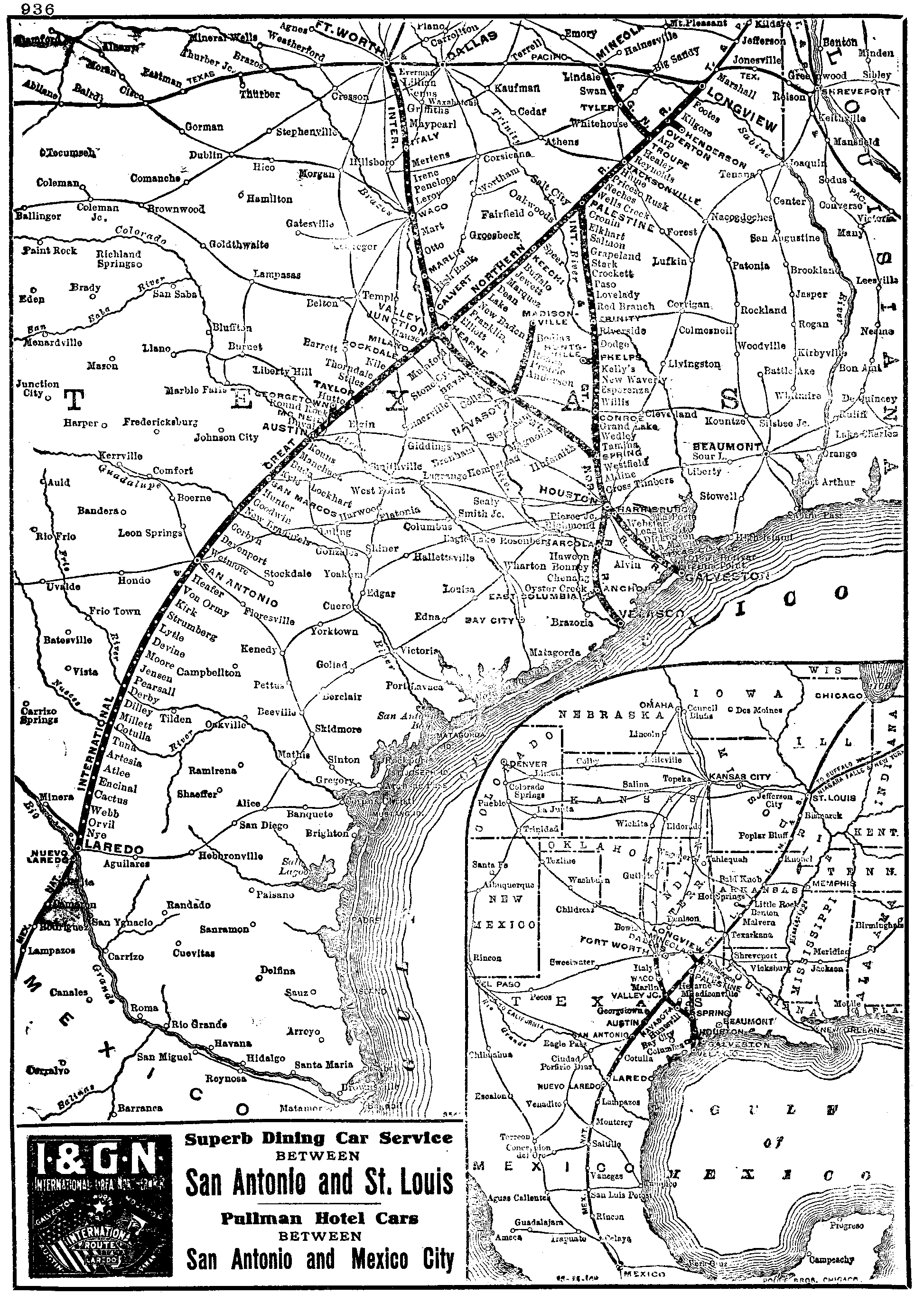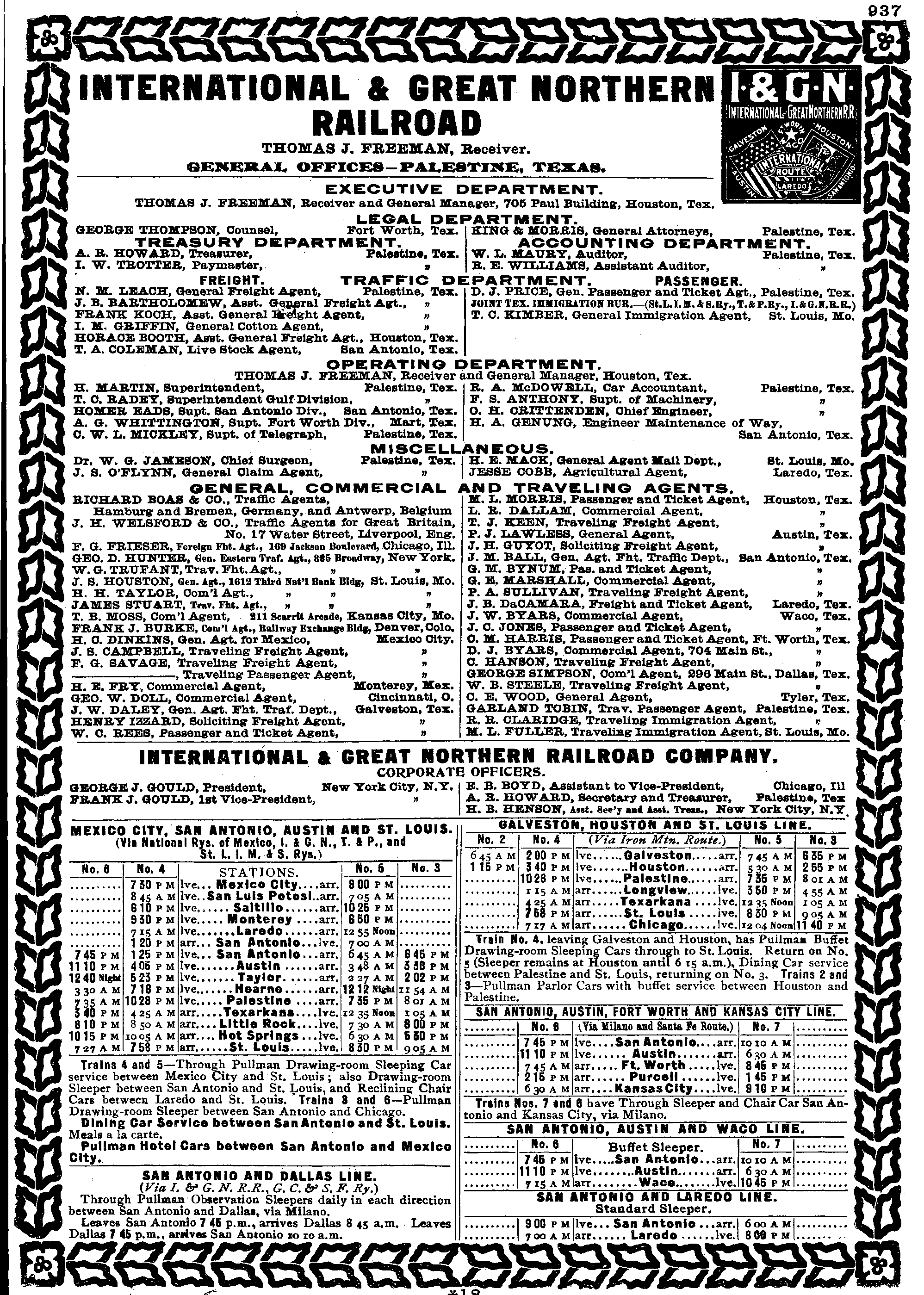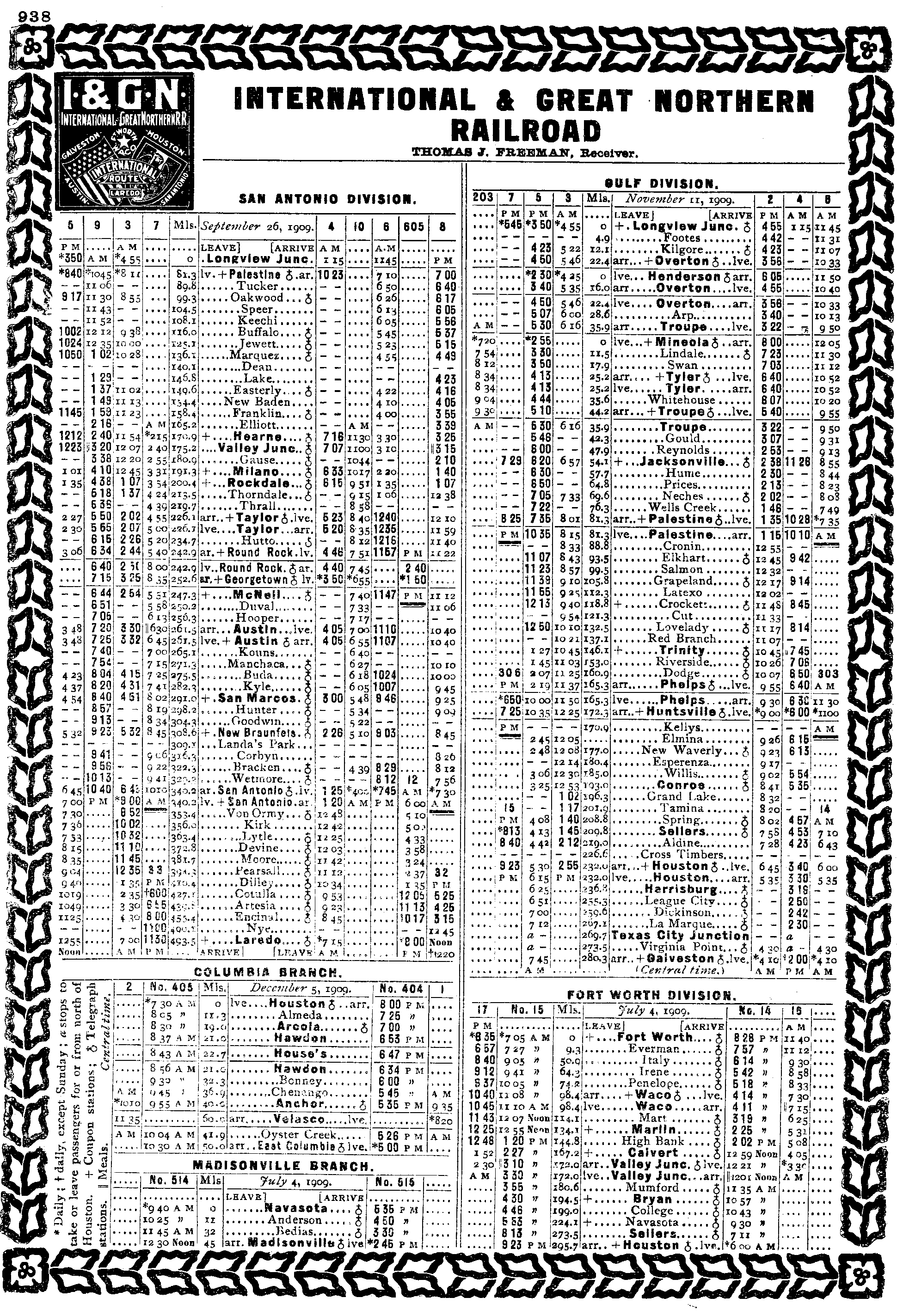International-Great Northern Railroad: Map, History, Timetables
Published: October 18, 2023
By: Adam Burns
The International – Great Northern Railroad (I&GN) was a railroad company that operated in the U.S. state of Texas.
It was created on September 30, 1873 through a merger of the International Railroad and the Houston and Great Northern Railroad. The railroad was initially designed to connect Texas with the north, but it eventually expanded to include routes to the Gulf of Mexico.
In 1925, the I&GN was incorporated into the Missouri Pacific Railroad, which is now part of the Union Pacific Railroad.
History
The International – Great Northern Railroad was a significant railway company during the growth of the railway industry in the United States. Its operation commenced in 1873 when the Houston and Great Northern Railroad and the International Railroad combined their lines to form a more extensive network.
The creation of the railroad was part of the larger expansion of the railway across the United States in the 19th century. The connections it established from Houston and Fort Worth, as well between Longview and Laredo, provided new opportunities for trade, contributed to the economic development of Texas, and improved accessibility and interaction across different regions.
The Houston and Great Northern was officially chartered on October 22, 1866, after the Civil War. It had both local and eastern financial backing and owned 252 miles of track when it merged with the International Railroad. This included tracks from Houston to Palestine and East Columbia, and several branch lines. In addition, it included the Houston Tap and Brazoria Railroad and the Huntsville Branch Railway.
The International Railroad, chartered on August 5, 1870, added another 177 miles of track between Hearne and Longview when it joined forces with the Houston and Great Northern. Despite facing financial turmoil in 1873, expansion continued at a slow pace, reaching Austin by December 28, 1876, and San Antonio and Laredo by December 1, 1881.
The company also acquired and merged with Georgetown Railroad Company in 1879 and Henderson and Overton Branch Railroad Company in 1880, although the latter was not consolidated until August 31, 1911. Throughout these periods of financial difficulty and expansion, the company played a significant role in Texas's railroad history.
In December, 1880 the renowned tycoon Jay Gould gained control of the International – Great Northern. Gould was a significant player in the railroad industry, known for his aggressive business tactics and propensity to monopolize the railroad industry.
The I&GN fell into receivership in 1entered receivership on April 1, 1878, was sold at foreclosure. A year later, a new organized company utilizing the original charter acquired the property on November 1, 1879.
Gould's ownership of the I&GN, due to financial mismanagement and operation, resulted in a second receivership on February 21, 1889, which lasted more than three years. The newly reorganized operation, retaining the original name and without sale, occurred on July 11, 1892.
In its prime, the railroad spanned a total distance of over 1,106 miles. The lines stretched from Fort Worth to Houston, Laredo, and Galveston. It connected with the Texas & Pacific at Longview and through friendly connections with the St. Louis, Iron Mountain and Southern Railway provided through service to St. Louis, Missouri.
Presently, most of the International – Great Northern's key main line is still active under Union Pacific while many secondary branches have since been abandoned.. The legacy that the railroad has left behind in the history of the railway industry continues to resonate.
At A Glance
Longview - Laredo Valley Junction - Fort Worth Palestine - Houston - Galveston/Velasco Spring - Valley Junction Navasota - Madisonville Troupe - Mineola | |
Jay Gould
Before his involvement with the railroad, Jay Gould had been a successful tanner and speculative financier. His entry into the railroad industry initiated with his control over the Erie Railroad in 1867. His subsequent acquisition of the International – Great Northern made quite a few headlines.
Gould displayed his business acumen in the way he administered the I&GN from 1880 until his Missouri, Kansas and Texas Railway canceled its lease of the system on March 2, 1888.
His son, George, attempted to resecure the I&GN as part of his efforts to complete a true, coast-to-coast transcontinental railroad. However, the younger Gould lost control of the system, as well as the Missouri Pacific, following 1907's financial panic.
The MP would later regain control of the International – Great Northern when subsidiary New Orleans, Texas and Mexico Railway acquired the property on January 1, 1925. The merger expanded the Missouri Pacific network and facilitated the accessibility and convenience of railroad transportation across these regions.
The creation of the International – Great Northern had a significant economic influence on the regions it served. It facilitated increased trade and economic growth, marking an era of development, collaboration, and progress in the American railroad industry.
System Map (1910)
Legacy
The I&GN was more than merely a transportation network. It played an essential role in shaping the history and advancing the economic development of the United States during the 19th and early 20th centuries.
The I&GN played its part in the overall growth of the nation’s railway system. Its acquisition by the Missouri Pacific further augmented the extension and connectivity of the rail network, further enhancing the convenience of transportation.
Today, the remnants of the International – Great Northern Railroad serve as a reminder of the pivotal role the railroad played in shaping the culture and economic fortunes of the communities it served.
After multiple receiverships, the International – Great Northern Railroad regained control under the Missouri Pacific system in 1925. This shift in ownership led to enhancements in the services offered, raising the quality of railroad transportation in the regions it served.
Through its several twists and turns, the International – Great Northern Railroad was an eloquent testament to the power of innovation, the pursuit of development, and the importance of transportation in shaping the economic history of a nation.
The longevity and residual impact of the International – Great Northern Railroad symbolize the enduring legacy of a thriving era in the history of the American railroad industry, reminding us that this once flourishing railroad was an instrumental force that moved a nation forward.
When Jay Gould managed the International – Great Northern Railroad, his tenure marked a period of sustained expansion and advancement. Under Gould, the railroad improved its stability and profitability significantly.
In the end, the acquisition of the International – Great Northern Railroad by Missouri Pacific unfolded a new chapter in the railroad's history, leading to its eventual integration into the Union Pacific system.
The International – Great Northern Railroad was quintessential in forging powerful and productive trade channels between various regions, particularly in Texas and Missouri. It opened gateways to undiscovered geographical territories, thus fostering economic options, growth, and prosperity.
Jay Gould’s management tactics may have been controversial at times, but it naturally propelled the International – Great Northern Railroad towards a more stable and profitable future, setting it on a path to become part of the formidable Missouri Pacific system.
The Missouri Pacific's acquisition of the International – Great Northern marked the culmination of a tumultuous journey for the railroad. In 1950 the MP contained 9,700 route miles and served every major city in the southern Midwest and Texas except Amarillo and Oklahoma City.
Timetables (1910)
Despite its modest beginnings, the International – Great Northern Railroad, backed by powerful leaders like Jay Gould and supported by strategic partnerships with Missouri Pacific, etched its name in the annals of American industrial history.
The International – Great Northern's infrastructure played a crucial role in the socio-economic development of the regions it served. The railroad's substantial commercial impact solidified its crucial position as a dynamic component of the American transportation industry.
The active section of the International – Great Northern Railroad today remains a tribute to the company's historical importance. While much of the original line has been abandoned, this section continues to echo a legacy of resilience, adaptation, and sustained relevance.
The International – Great Northern Railroad was testament to the transformative power of railroad technology in the 19th and early 20th centuries. It illustrated how the ability to move goods and people could utterly reshape the economy and society at large.
Conclusion
Jay Gould's leadership during his tenure at the International – Great Northern Railroad, albeit turbulent, carved a path for the company towards redeeming its financial stability and securing its future survival.
The Missouri Pacific's acquisition of the International – Great Northern Railroad epitomizes the enduring value of strategic partnerships in the progress and prosperity of a business, shaping a resilient and sustainable future amidst challenges.
Reflecting on the story of the International – Great Northern Railroad provokes us to appreciate the ingenuity of the human spirit and the transformative potential of infrastructural development. The legacy of the railroad endures, a testament to a pivotal period in American history.
Sources
- Cline, Wayne. Texas Railroad, The: The Scandalous And Violent History Of The International And Great Northern Railroad, 1866-1925. Lexington: 2015.
- Miner, Craig H. Rebirth Of The Missouri Pacific, 1956-1984, The. College Station: Texas A&M University Press, 1983.
- Schafer, Mike. More Classic American Railroads. Osceola: MBI Publishing, 2000.
Recent Articles
-
Connecticut Christmas Train Rides In Essex!
Dec 19, 25 04:55 PM
While spring through fall bring daily excursions and seasonal special events at the Essex Steam Train, it’s the North Pole Express—its signature holiday journey—that has become a treasured tradition f… -
Colorado Christmas Train Rides In Georgetown!
Dec 19, 25 04:35 PM
The Georgetown Loop Railroad, a historic narrow-gauge line high in Colorado’s Rockies, firmly belongs in the latter category—especially during its Christmas season rides. -
North Carolina's "Whiskey" Train Rides
Dec 19, 25 04:30 PM
This article will delve into the charm of these whiskey train rides, their offerings, historical context, and why they deserve a spot on your travel itinerary.






